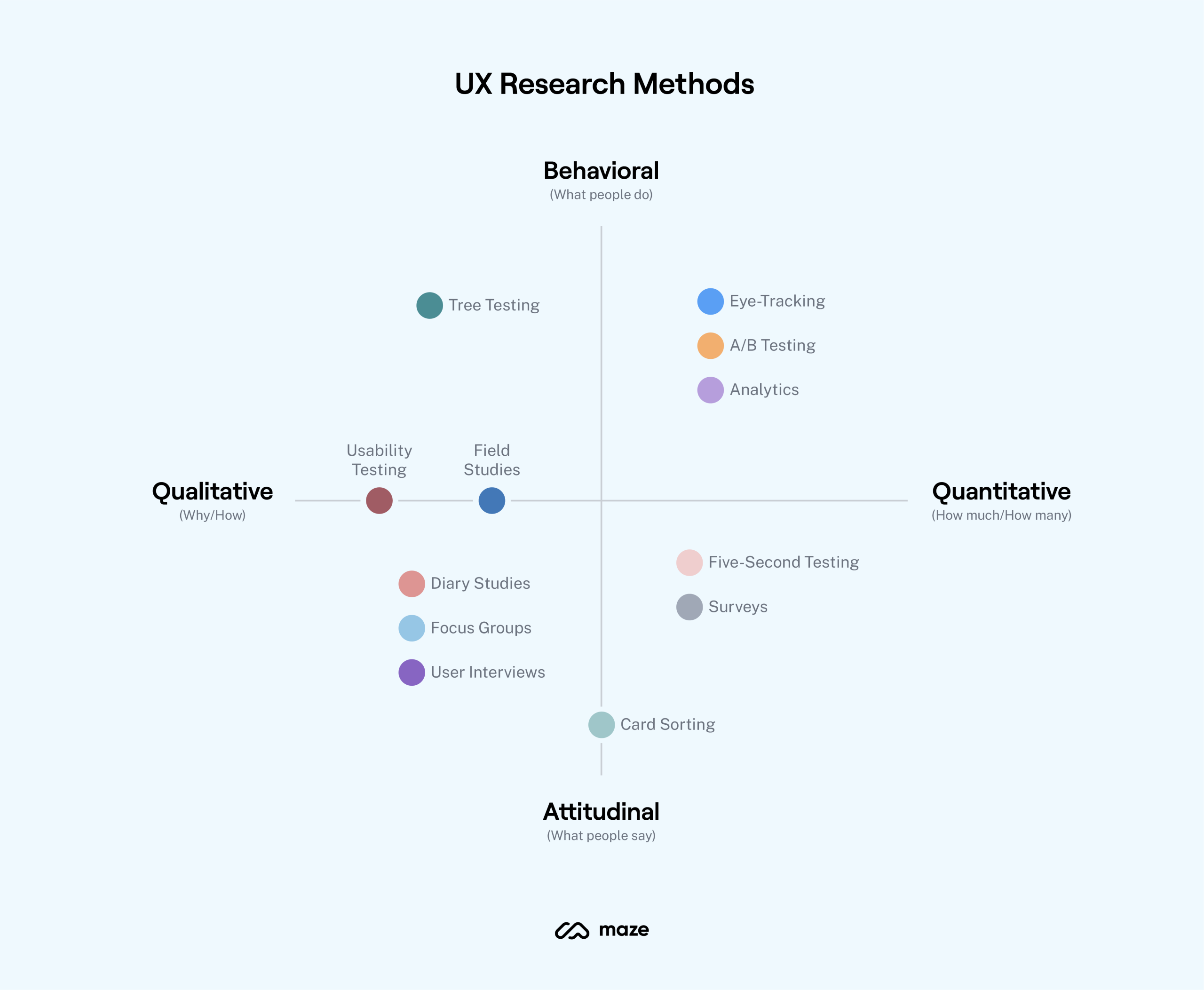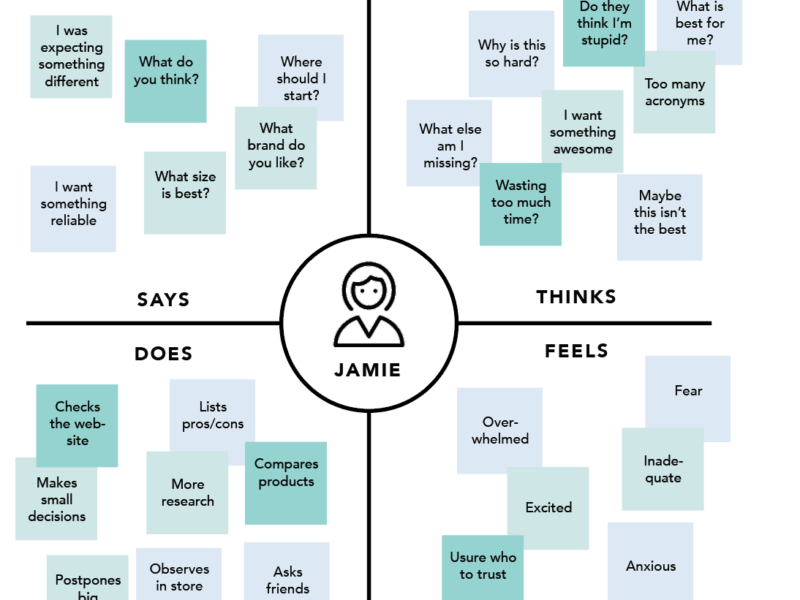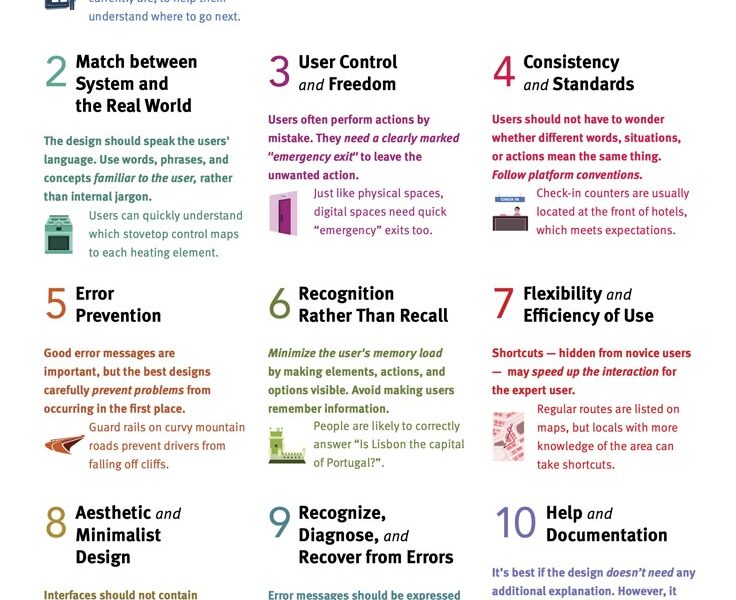A Comprehensive Guide for Effective User Experience Design
User Experience (UX) research is the backbone of designing products that resonate with users. By understanding behaviors, needs, and motivations, designers can create intuitive and impactful solutions.
This guide explores key UX research methods, categorized into behavioral (what people do) and attitudinal (what people say), with a focus on qualitative and quantitative approaches.
Whether you’re a seasoned designer or new to the field, this resource will help you choose the right tools for your projects.
Why UX Research Matters
UX research bridges the gap between assumptions and reality. It uncovers actionable insights, reduces design risks, and aligns teams with user-centric goals. According to the Nielsen Norman Group, companies that invest in UX research see a 100% ROI through improved conversion rates and reduced development costs.
Behavioral UX Research Methods
Behavioral UX Research methods focus on observing user actions. These are split into qualitative (exploring “why/how”) and quantitative (measuring “how much/many”).
1. Qualitative Behavioral Methods
Usability Testing
What it is: Observing users interact with a product to identify pain points.
When to use: During prototyping or post-launch to refine workflows.
Example: Asking users to complete tasks like “Check out with a coupon” while noting confusion points.
Reference: Usability.gov’s Guide
Field Studies
What it is: Studying users in their natural environment (e.g., homes or workplaces).
When to use: Early in the design process to understand context.
Example: Observing nurses using a hospital app during shifts.
Reference: Interaction Design Foundation
User Interviews
What it is: One-on-one discussions to explore motivations and challenges.
When to use: To gather deep insights during discovery phases.
Tip: Use open-ended questions like, “What frustrates you about this process?”
Reference: NN/g’s Interview Guide
Focus Groups
What it is: Moderated group discussions to gauge collective opinions.
When to use: For brainstorming ideas or testing concepts with diverse users.
Limitation: Risk of groupthink; pair with individual interviews.
Reference: Qualtrics Focus Group Guide
Card Sorting (Qualitative)
What it is: Asking users to organize topics into categories, revealing mental models.
When to use: Designing information architecture (IA) for websites/apps.
Example: Users group e-commerce products into “Men’s Wear” or “Accessories.”
Reference: Optimal Workshop’s Card Sorting Guide
2. Quantitative Behavioral Methods
A/B Testing
What it is: Comparing two versions of a page to see which performs better.
When to use: Optimizing CTAs, layouts, or copy.
Case Study: Airbnb increased sign-ups by 30% by testing headline variations.
Reference: Optimizely A/B Testing Guide
Analytics
What it is: Analyzing quantitative data (e.g., bounce rates, click paths).
When to use: Continuously monitor user behavior post-launch.
Tools: Google Analytics, Hotjar, Mixpanel.
Reference: Google Analytics Academy
Tree Testing
What it is: Evaluating IA by asking users to find items in a text-only menu.
When to use: Validating navigation structures before UI design.
Tool: Treejack by Optimal Workshop
Five-Second Testing
What it is: Showing users a design for five seconds, then asking recall questions.
When to use: Testing first impressions of landing pages or ads.
Example: “What was the main offer on that screen?”
Reference: UsabilityHub’s Five-Second Test
Surveys (Quantitative)
What it is: Structured questionnaires to collect numerical data.
When to use: Measuring satisfaction (e.g., NPS) or feature popularity.
Tool: Typeform, SurveyMonkey.
Reference: SurveyMonkey Best Practices
Card Sorting (Quantitative)
What it is: Closed sorting where users assign items to predefined categories.
When to use: Validating IA hypotheses statistically.
Analysis: Use tools like IBM SPSS for cluster analysis.
Attitudinal UX Research Methods
Attitudinal UX Research methods focus on self-reported data—users’ opinions, beliefs, and preferences.
Diary Studies
What it is: Users log experiences over days or weeks.
When to use: Studying long-term behaviors (e.g., fitness app usage).
Tool: dscout
Reference: UX Booth’s Diary Study Guide
Customer Feedback Analysis
What it is: Mining reviews, emails, or chat logs for themes.
When to use: Identifying recurring pain points post-launch.
Tool: Medallia
Persona Development
What it is: Creating archetypes based on user interviews/surveys.
When to use: Aligning teams around user needs.
Example: “Busy Brian,” a persona for a productivity app.
Reference: Smashing Magazine’s Persona Guide
Choosing the Right Method
- Define Goals: Are you exploring (qualitative) or validating (quantitative)?
- Stage of Project:
- Discovery: Field studies, interviews.
- Design: Usability testing, card sorting.
- Optimization: A/B testing, analytics.
- Resources: Budget, time, and tools.
Case Studies
- Spotify: Used diary studies to redesign playlist creation.
- Amazon: Leverages A/B testing to refine checkout flows, boosting conversions by 15%.
- Google: Combines eye-tracking (Tobii Pro) and surveys to optimize search results.
Conclusion
UX research is not a one-size-fits-all process. By blending behavioral and attitudinal methods, designers can create holistic, user-driven solutions. Start small—try a five-second test or a quick survey—and scale as you gain confidence. Remember, the best designs are rooted in empathy and evidence.
Further Reading:



One thought on “UX Research Methods”